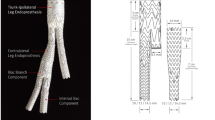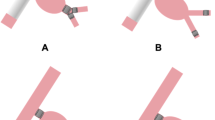Abstract
Objective
To evaluate the impact of compliance with anatomical guidelines on outcomes of endovascular aortic aneurysm repair using “bell-bottom” stent grafts (BBSGs).
Methods
This is a retrospective review from January 1999 to May 2012 of patients who underwent endovascular infrarenal abdominal aneurysm repair and whose iliac limbs were greater than 18 mm in diameter. Computed tomography angiography was utilized for compliance with anatomical guidelines as stated in manufacturer’s instructions for use (IFU). The primary outcome observed was iliac limb events. The secondary outcome observed was the need for re-intervention due to BBSG failure.
Results
Of the 376 BBSGs, 55 (15%) in 27 patients met IFU. Aneurysm exclusion was achieved in all patients. The mean follow-up was 44 ± 30 months. Twenty-eight patients (11%) had 29 iliac limb events (12 type 1b endoleaks, 4 aneurysm sac growth, 4 stenosis/kink, 4 retrograde migrations, 2 component separations, 2 ruptures and 1 limb occlusion); all among patients treated outside of IFU (p < 0.04). The rate of aneurysm sac enlargement was similar between both groups, at 56%, respectively, between those treated within and those treated outside of IFU. On multivariate regression analysis, larger common iliac artery (CIA) (HR 1.088, 95% CI 1.016–1.166, p = 0.016), greater CIA tortuosity (HR 2.352, 95% CI 1.004–5.509, p = 0.048) and limbs with more than two characteristics that did not meet IFU criteria (HR 3.84, 95% CI 1.15–12.83, p = 0.03) were associated with higher rates of BBSG events and re-interventions.
Conclusions
BBSGs effectively seal ectatic CIAs. But rates of iliac limb events and re-interventions are higher among patients who do not meet IFU criteria. The larger CIA diameter, the greater CIA tortuosity and more than two criteria not met by IFU were associated with BBSG failure and re-intervention.

Similar content being viewed by others
References
Parodi JC, Palmaz JC, Barone HD. Transfemoral intraluminal graft implantation for abdominal aortic aneurysms. Ann Vasc Surg. 1991;5(6):491–9.
Armon MP, Wenham PW, Whitaker SC, Gregson RH, Hopkinson BR. Common iliac artery aneurysms in patients with abdominal aortic aneurysms. Eur J Vasc Endovasc Surg. 1998;15(3):255–7.
Senapati A, Browse NL. Gluteal necrosis and paraplegia following postoperative bilateral internal iliac artery occlusion. J Cardiovasc Surg (Torino). 1990;31(2):194–6.
Razavi MK, DeGroot M, Olcott C 3rd, et al. Internal iliac artery embolization in the stent-graft treatment of aortoiliac aneurysms: analysis of outcomes and complications. J Vasc Interv Radiol. 2000;11(5):561–6.
Jimenez JC, Smith MM, Wilson SE. Sexual dysfunction in men after open or endovascular repair of abdominal aortic aneurysms. Vascular. 2004;12(3):186–91.
Karch LA, Hodgson KJ, Mattos MA, Bohannon WT, Ramsey DE, McLafferty RB. Management of ectatic, nonaneurysmal iliac arteries during endoluminal aortic aneurysm repair. J Vasc Surg. 2001;33(2 Suppl):S33–38.
Naughton PA, Park MS, Kheirelseid EA, et al. A comparative study of the bell-bottom technique vs hypogastric exclusion for the treatment of aneurysmal extension to the iliac bifurcation. J Vasc Surg. 2012;55(4):956–62.
Timaran CH, Lipsitz EC, Veith FJ, et al. Endovascular aortic aneurysm repair with the Zenith endograft in patients with ectatic iliac arteries. Ann Vasc Surg. 2005;19(2):161–6.
Kirkwood ML, Saunders A, Jackson BM, Wang GJ, Fairman RM, Woo EY. Aneurysmal iliac arteries do not portend future iliac aneurysmal enlargement after endovascular aneurysm repair for abdominal aortic aneurysm. J Vasc Surg. 2011;53(2):269–73.
Falkensammer J, Hakaim AG, Andrew Oldenburg W, et al. Natural history of the iliac arteries after endovascular abdominal aortic aneurysm repair and suitability of ectatic iliac arteries as a distal sealing zone. J Endovasc Ther. 2007;14(5):619–24.
McDonnell CO, Semmens JB, Allen YB, Jansen SJ, Brooks DM, Lawrence-Brown MM. Large iliac arteries: a high-risk group for endovascular aortic aneurysm repair. J Endovasc Ther. 2007;14(5):625–9.
Lavee J, Schneiderman J, Bass A, Amsterdam E, Walden R, Adar R. Tube graft replacement of abdominal aortic aneurysm: is concomitant iliac disease a contraindication? J Cardiovasc Surg (Torino). 1988;29(4):449–52.
Ballotta E, Da Giau G, Gruppo M, Mazzalai F, Toniato A. Natural history of common iliac arteries after aorto-aortic graft insertion during elective open abdominal aortic aneurysm repair: a prospective study. Surgery. 2008;144(5):822–6.
Rutherford RB. Open versus endovascular stent graft repair for abdominal aortic aneurysms: an historical view. Semin Vasc Surg. 2012;25(1):39–48.
Hobo R, Sybrandy JE, Harris PL, Buth J. Endovascular repair of abdominal aortic aneurysms with concomitant common iliac artery aneurysm: outcome analysis of the EUROSTAR experience. J Endovasc Ther. 2008;15(1):12–22.
Gray D, Shahverdyan R, Reifferscheid V, Gawenda M, Brunkwall JS. EVAR with flared iliac limbs has a high risk of late type 1b Endoleak. Eur J Vasc Endovasc Surg. 2017;54(2):170–6.
Wang Y, Li C, Xin H, Li J, Wang H. Predisposing factors for migration of the iliac limb and reintervention after endovascular abdominal aortic aneurysm repair. Ann Vasc Surg. 2019;59:91–101.
https://www.goremedical.com/ap/news/exclduer-ibe-fda-approval.
Giosdekos A, Antonopoulos CN, Sfyroeras GS, Moulakakis KG, Tsilimparis N, Kakisis JD, Lazaris A, Chatziioannou A, Geroulakos G. The use of iliac branch devices for preservation of flow in internal iliac artery during endovascular aortic aneurysm repair. J Vasc Surg. 2019;S0741-5214(19):32638-2. https://doi.org/10.1016/j.jvs.2019.10.087
Funding
This study was not supported by any funding.
Author information
Authors and Affiliations
Corresponding author
Ethics declarations
Conflict of interest
The authors declare that they have no conflict of interest.
Ethical Approval
For this type of study, formal consent is not required.
Informed Consent
Informed consent was obtained from all individual participants included in the study.
Consent for Publication
Consent for publication was obtained for every individual person's data included in the study.
Additional information
Publisher's Note
Springer Nature remains neutral with regard to jurisdictional claims in published maps and institutional affiliations.
Rights and permissions
About this article
Cite this article
Erben, Y., Oderich, G.S., Kalra, M. et al. Impact of Compliance with Anatomical Guidelines of “Bell-Bottom” Iliac Stent Grafts for Ectatic or Aneurysmal Iliac Arteries. Cardiovasc Intervent Radiol 43, 1143–1147 (2020). https://doi.org/10.1007/s00270-020-02489-3
Received:
Accepted:
Published:
Issue Date:
DOI: https://doi.org/10.1007/s00270-020-02489-3




